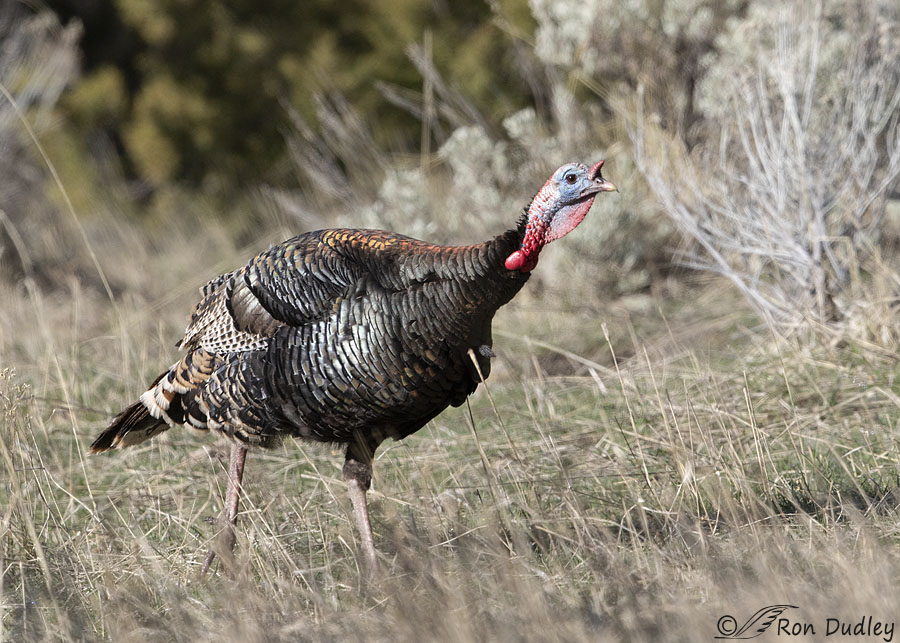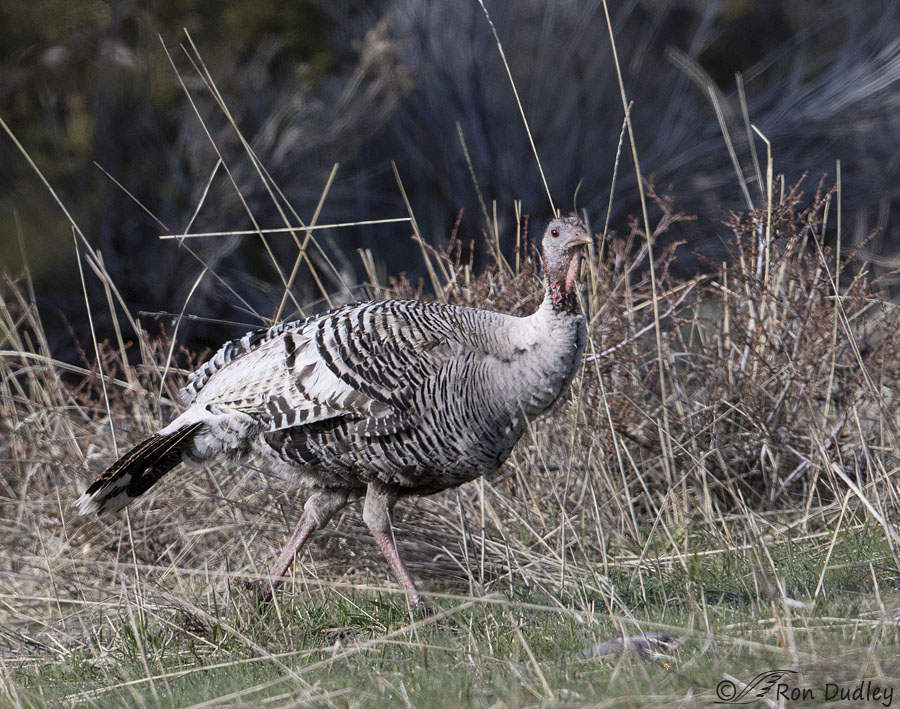I’ve only seen two smoke morph Wild Turkeys ever. The first one was over thirty years ago. The second was yesterday.

Yesterday morning I finally got out again, this time into the mountains of the west desert. I didn’t find many birds but I did spend some time with a flock of Wild Turkeys. They were reluctant to come out into the open, spending most of their time in a stand of junipers so I didn’t get any great photos.
It was a mixed flock of hens and several toms with most of them having typical coloration for Wild Turkeys, much like this tom who came out into the relative open for just a moment.
But one of the hens really stood out.

She was a smoke morph (sometimes called smoke phase). Smoke morphs are a light wispy gray with graphite and black details along the body, wings, and tail. She was striking and beautiful, much more so than she appears in this mediocre photo.
It’s a common fallacy that smoke morphs are Wild Turkey/domestic turkey hybrids but that’s not the case. It’s a mutation that occurs occasionally in Wild Turkey populations and it’s expression is controlled by a single recessive gene.
Since the gene is recessive a turkey must have two of them to be a smoke morph – those turkeys having only one of them are carriers for the trait and have normal coloration. Both parents must be carriers for any of their offspring to be smoke morphs. Since the gene isn’t very common in the population in the first place the chances of both parents being carriers are small and even when that happens only 25% of their offspring will be smoke morphs, on average.
That previous paragraph just might bring back memories of your high school biology class…
Smoke morph turkeys may be less unusual than I thought. Audubon says that as many as 1% of Wild Turkeys may be smoke morphs.
But since this bird was only my second one she caught my attention and I thought viewers might like to see her.
Ron
Note: Smoke morph turkeys are not melanistic, leucistic or albino although all three are known to occur in turkey populations.


Love this lovely, unusual bird. Like many followers here I have never heard of a smoke morph but color mutations are in all species. She is simply beautiful. I would think this color morph would make a turkey more vulnerable to depredation. Once again you have wowed and made my day!
Fascinating post. Color morphs in birds seems to be fairly common. Makes one wonder what other species have such striking variations other than albinism. I also was curious about the “horn” on the tom. A snood (yes, I looked it up), which sounds like a name out of Dickens.
Lyle, I got a pretty interesting photo of a snood today that I might be posting tomorrow. Stay tuned.
Oops, I thought they were degrees of albinism. I stand corrected. Very interesting plumage deviation.
Thank you, Ken.
Thanks for sharing this info! I’m always learning something new at your site. She is indeed a beautiful bird!
Glad to know you’re leaning here, Joanne. Thanks.
Ron,
Never say mediocre! And it was educational as usual. I have to say that I might not use the word “beautiful” for a wild turkey, they looking closer to vultures than a Meadowlark IMHO! And thanks for the Mendelian Review! Right back to medical school!
Stephen
I’ll be honest, Stephen. Beautiful popped into my mind the moment I saw her through my lens. An eye of the beholder kind’a thing I guess…
As always I learn, and marvel at your posts, and the knowledgeable people who comment here. I see beauty that I will not see any other way as well.
Many, many thanks.
Thank you, EC.
Beautiful pictures. A very interesting and enjoyable post this morning. I always seem to learn something new as I read both the post and the comments. I hope everyone is safe and staying healthy.
Thank you, Betty. Stay safe and healthy yourself.
Oh how I wish I’d have had a biology teacher like you. My life might have taken a whole different path. Instead, I drew a lecherous old man who turned me off the mere idea of science for YEARS–until my innate curiosity took over. THANK YOU for the lesson, the knowledge and the gorgeous image. What a beauty! Oh how I love the diversity of Nature!!
Didn’t thrill me much until I got a wonderful biology teacher in Jr. College. Whole world of difference when it relates to you and your life…….. 🙂
I appreciate the very kind words, Laura. My high school biology teacher wasn’t the best but he wasn’t the worst either. My best teachers were both English teachers – some thought of them as old battleaxes but man did I ever learn a lot from them. Thank you Mrs. Myhre and Mrs. Dresen.
YES.
Thank you Ron. I’ve never heard of a smoke morph bird of any type. She is striking.
Diana
She certainly is, Diana.
I’ve seen lots of turkeys, but never a smoke morph. I didn’t know there were any unusual color morphs for turkeys. I enjoy your photos, but your knowledge keeps me coming back too.
Thanks, Nancy. There are actually four different color morphs in Wild Turkeys, in addition to “normal”.
Ooh, she’s quite lovely! And of course, as soon as I read “single” and “recessive” (although I’d use “allele” instead of “gene”), my brain was off and running picturing the Punnett square. You can take the girl out of the biology classroom… 😉
Marty, I considered using “allele” but not everyone has the genetics vocabulary you and I do so I decided to go with gene.
Hi Ron, You are up bright and early! I live in W. Massachusetts, in the woods. We have lots of Wild Turkeys…35 came up our driveway and into the forest not long ago. They are so beautiful, Thanks everyday! Somehow I can never seen your reply to my comments (though I seldom make one). Thank you so much for the beauty and wonder you bring.
Ha, I’m always up bright and early. Often too damned early, Mary.
I have no idea why you wouldn’t be able to see my replies to your comments.
Interesting. We here in the foothills of Northern CA had a smoke morph (didn’t know it was called that till you told me) for some years in our local flock. Three years, I think, though I didn’t write down the sightings. She was even paler than the one in your nice photograph. I did learn from her that “our” flock has a range of about a five-mile circle, since there were sightings of her in that area over those years. She was distinct enough that we could safely say it was the same turkey. I’ve seen another more recently, in the same flock. She’s not as light as the first, more like the one you photographed. Wonder if the males are ever “smoky” Joes.
“She was even paler than the one in your nice photograph”
Makes sense, Sallie. I read that there’s quite a bit of variation in the amount of white/light gray in smoke morph.
They don’t understand why but very, very few males are smoke morphs.
You might think this post was written by a retired biology teacher 🙂
Very interesting Ron and definitely educational. Have never seen a wild turkey although they occasionally can be found here.
Thanks, Everett. I hope you get to see some of them someday. I was lucky enough to find this same flock again this morning.
I have never seen a smoke morph in AZ, KY, NC, or WI.
Does the smoke morph form appear more commonly in one area of the country?
“Does the smoke morph form appear more commonly in one area of the country?”
Not that I’m aware of, Pam. I didn’t see anything about that in my research.
She is different and beautiful. Don’t have many around here tho a flock has taken to liking Ft. Benton at the moment with less human activity out and about. 😉 Biology “refresher”/lesson always appreciated….. 🙂 Glad you could get out yesterday. It’s 11 this morning after a high of 16 yesterday – still snow on the ground tho ground is warm and sucking it up. 🙂
Thanks, Judy. It’s colder this morning here than it has been for a while too.
You can count me as part of the ‘never seen’ group and we have a lot of them around. It is pretty common to see large flocks in the farm fields here and I would see them along the highway fields to the U.P. when I was doing my weekly trips to my mother’s. Not unusual to see the entire flock bolt across the road. While they do have a face that only a mother would love…when the light hits them in a certain way their colors just iridescences (sp?) beautifully. Now I’ll really have to be on the look-out…
Kathy, you’re very right about how important the light angle is when photographing this species. The right angle really lights up their colors.
Once again you had lucky timing. I have never heard of the smoke morph. I learned something new. Thanks Ron!
Thank you, Jean. The more persistent I am the more luck I have. Luck’s funny that way…
G-Morning Ron, Statistically you’re very fortunate to have spotted a Smoke Morph Turkey. We’ve spotted many Turkeys on our property and travels, but never spotted one. Thanks for sharing your fortunate experience with photo and “bio”. Stay Healthy! Don
Thanks, Don. One of the reasons for posting this is to find out how many of my readers have seen smoke morphs so I can get a better feel for how unusual they really are. Thanks for that feedback.
1% sounds pretty rare to me. If you into signs, what significant thing happened after seeing that first one? 😀 She’s a beautiful bird. I have a fondness for the wild turkey. And for the record? Benjamin Franklin was right.
“If you into signs, what significant thing happened after seeing that first one?”
Arwen, that was over thirty years ago. I can barely remember what I had for dinner last night… 🙂
I wouldn’t have had any problem if ol’ Ben had prevailed either.
LOLOLOL sounds like me on the memory issue. Particularly now…my husband and I are asking each other what day it is. I got out of bed last Saturday declaring I was late for work. I work M-F.